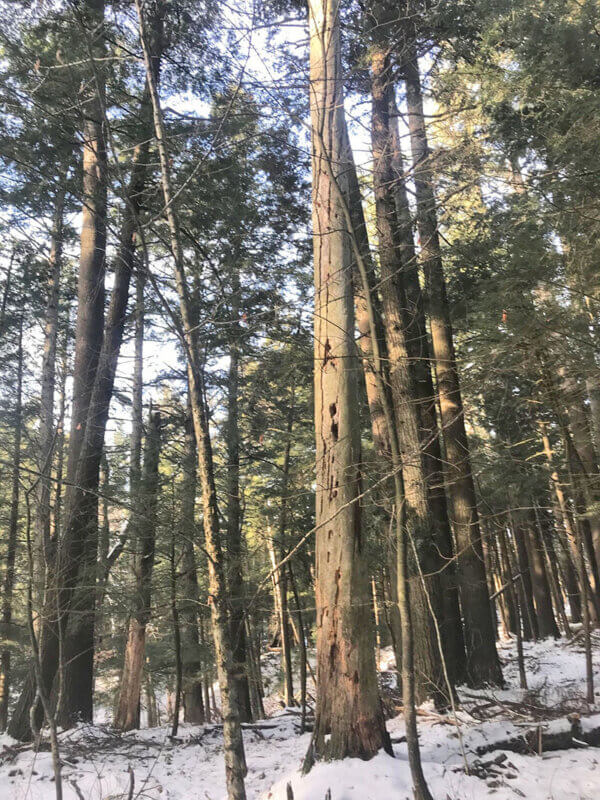Forests should be managed for carbon resiliency
In the midst of a climate crisis, many people are interested in forests’ ability to help mitigate climate change by sequestering and storing carbon. While managing forests for carbon may seem simple in principle, in practice it is incredibly nuanced, complex and unintuitive.

A “snag,” or dead-standing tree, is an example of how carbon is contained in both living and dead trees in the forest.
What is forest carbon? While we may picture carbon as some shapeless, amorphous substance, most carbon in the forest is, in short, wood. As a tree photosynthesizes, it sequesters carbon, sucking carbon dioxide out of the atmosphere. Combined with a few other elements, that carbon is transformed into sugars and starches which are used to help the tree grow, much of it ending up stored in the tree’s branches, trunk and roots. When that tree dies, some of its carbon will be released into the atmosphere through the process of decomposition, and some of it will be stored in the forest as dead wood and eventually as organic material in forest soils. Incredibly, only about one-third of the carbon in a typical Vermont forest is found in living trees. The majority — about 60 percent — is stored in the soil.
In the form of living trees and plants, carbon feeds and shelters thousands of species of living things, forming the living structure around which the forest community is built. In the form of dead wood, carbon benefits forest hydrology, provides habitat for mammals, amphibians, insects and fungi, and enriches forest soils. Forests are not carbon factories; carbon is a co-benefit of healthy forested ecosystems, one which must be considered alongside wildlife habitat, biodiversity and many other vital qualities, functions and values. Forest management will always be a balance between many things; we cannot responsibly manage forests solely for carbon any more than we can manage them solely for timber or for any other individual resource.
While research suggests that unmanaged forests store more carbon than managed forests in the short-term, our forests are young and altered, vulnerable to large-scale natural disturbances and to an expansive array of threats and stressors which fundamentally challenge their ability to grow, to thrive, and thus, to sequester and store carbon in the future. While it would be comforting to believe it, leaving all of our forests unmanaged is not a viable or responsible long-term strategy for carbon or for climate mitigation.
Instead, we need to focus on resilient carbon: carbon which is stored in healthy, diverse, resilient forests. In many, if not most, cases, management will be necessary to help forests develop qualities like multi-generationality and diversity which are integral to their ability to be resilient and adaptable in a changing climate, as well as to respond to the countless forest health and biodiversity threats that they face. This will often mean removing some carbon from forests in the short-term (cutting trees) in order to safeguard their ability to sequester and store carbon in the long-term. This carbon will not be a loss; it will be an investment in a more abundant and resilient future.
As we consider the nuances of forest carbon, we must also recognize the present and future carbon costs of our lives. When we use carbon as a justification for saying “not in my backyard” to forest management, we often trade local wood for wood produced in industrial forests which use much less carbon-friendly practices or for resources like steel and concrete which have massive carbon footprints. We engage in the illusion of preservation, displacing the impacts of our consumption on ecosystems somewhere else and on people without the privilege of saying “not in my backyard,” likely with a much greater cost to our forests, our climate and our global community.
The future of forest carbon is not a landscape of unmanaged forests; it is a landscape where forests are managed for resilience and adaptability, for biodiversity, for local, renewable resources and for resilient carbon, all at once. As we try to protect our forests and ourselves in a changing climate, it is critical that we reject simple and incomplete solutions in favor of nuance and complexity, and that we do the right thing even when it makes us uncomfortable. Resilient carbon is another example of what is so often the case in our forests: What is simple is rarely true, and what is necessary is rarely easy.
(Ethan Tapper is the Chittenden County Forester for the Vermont Department of Forests, Parks and Recreation. See what he’s been up to, check out his YouTube channel, sign up for his eNews and read articles he’s written here.)

